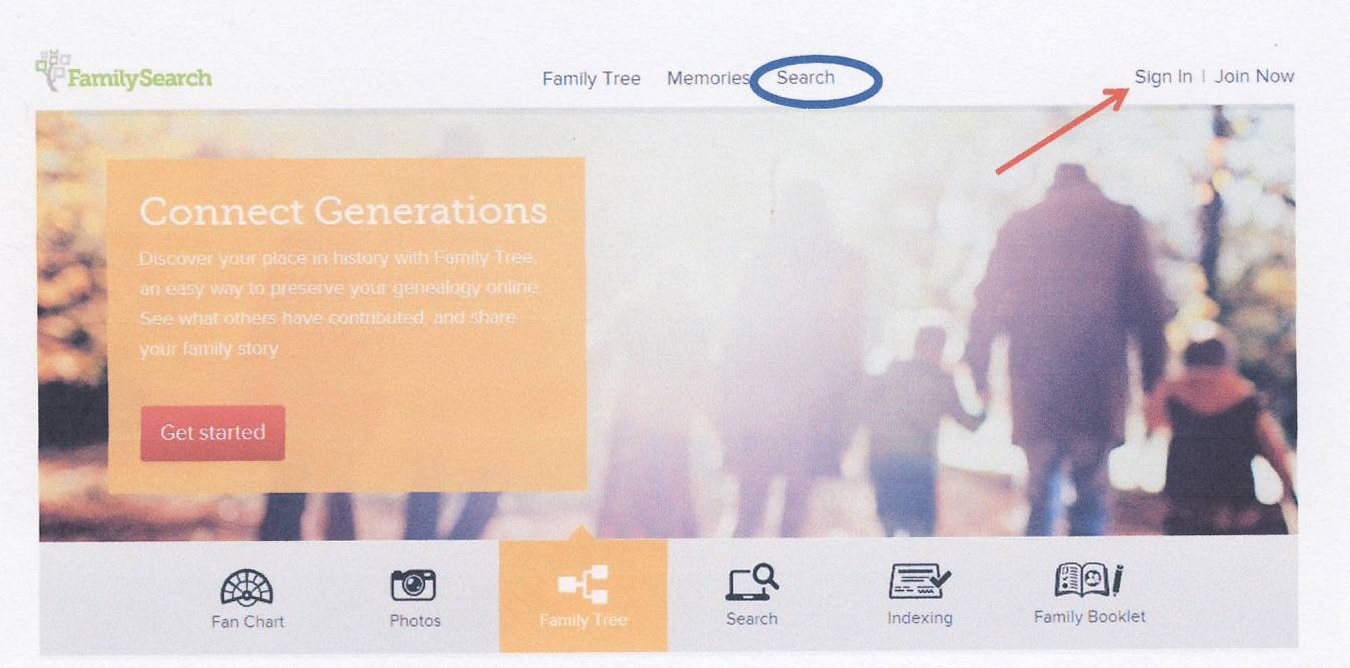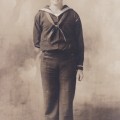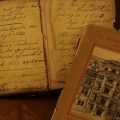When most people think of genealogy, they usually think of looking for dead people. When a genealogist looks for someone to collaborate with, the people who can be helpful to them are people who are researching the same geographical place. People can also be helpful if they are researching the same surnames. If you find someone who is researching the same surname as you are and in the same place that you are, you likely share a common ancestor. If that common ancestor is within a few generations, the other researcher is a fairly close cousin which provides a wonderful feeling of kinship. In a previous post about using message boards, I shared the joy of finding Jessica, a cousin, by way of the website for Ireland Reaching Out. Jessica’s great-grandfather is my paternal grandmother’s brother which makes us second cousins once removed.
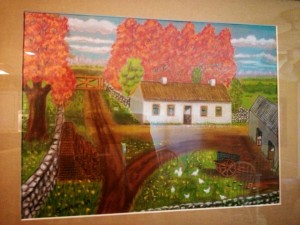 Jessica shared which me a painting of the Kenny family ancestral home in Ireland which is no longer standing. She also shared several stories about her great-grandfather, John Kenny, including this one. John Kenny immigrated to the United States in 1912. He tried a few other jobs before bartending for the first time on December 12, 1912. He loved bartending and did it most of the rest of his life except for during his service in the United States Army during World War I. Prohibition didn’t prevent him from bartending; he just had to keep the police paid well! It usually takes talking to a relative to find stories about ancestors like John Kenny’s love of bartending.
Jessica shared which me a painting of the Kenny family ancestral home in Ireland which is no longer standing. She also shared several stories about her great-grandfather, John Kenny, including this one. John Kenny immigrated to the United States in 1912. He tried a few other jobs before bartending for the first time on December 12, 1912. He loved bartending and did it most of the rest of his life except for during his service in the United States Army during World War I. Prohibition didn’t prevent him from bartending; he just had to keep the police paid well! It usually takes talking to a relative to find stories about ancestors like John Kenny’s love of bartending.
I have been fortunate to find cousins by way of several other websites including http://home.ancestry.com and https://familysearch.org. Both Ancestry and Family Search along with several other websites provide the opportunity to post your family tree online. When you post your family tree online, you have the opportunity to provide contact information so the other users of the website can contact you. While Ancestry provides you with space to post “your” family tree, Family Search 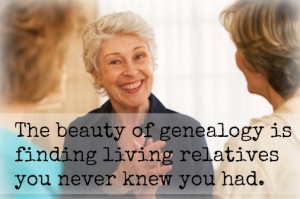 has one family tree to which all users contribute. For simplicity, I will refer to Family Search Family Tree as FS Family Tree. When adding people to FS Family Tree, you begin with yourself and then add information about previous generations. As a result, a relative may add one of your ancestors to FS Family Tree without connecting them to the rest of your ancestors because they don’t have the needed information to make the connection. Once you get back a few generations, it is a good idea to check for duplicates of your ancestors. It is easy to do through a link on each ancestor’s person page. I was working on FS Family Tree recently and checked for duplicates for my great-great-grandfather’s half-sister whose name is Mary Ann Black. I found a duplicate and after careful consideration, merged the two records. This new record for Mary Ann Black included contact information for the other contributor who added Mary Ann to FS Family Tree. I used this contact information to send an email inquiring if this other contributor had information concerning Mary Ann that she had not added to FS Family Tree. She responded that she was happy to know more about Mary Ann than she had known previously. Before I attached Mary Ann to the rest of her family, this cousin had not known who Mary Ann’s parents or sibling were. And yes, she did have more to add to FS Family Tree, which were pictures of Mary Ann and her husband. She was kind enough to send me copies of the pictures in addition to adding them to FS Family Tree.
has one family tree to which all users contribute. For simplicity, I will refer to Family Search Family Tree as FS Family Tree. When adding people to FS Family Tree, you begin with yourself and then add information about previous generations. As a result, a relative may add one of your ancestors to FS Family Tree without connecting them to the rest of your ancestors because they don’t have the needed information to make the connection. Once you get back a few generations, it is a good idea to check for duplicates of your ancestors. It is easy to do through a link on each ancestor’s person page. I was working on FS Family Tree recently and checked for duplicates for my great-great-grandfather’s half-sister whose name is Mary Ann Black. I found a duplicate and after careful consideration, merged the two records. This new record for Mary Ann Black included contact information for the other contributor who added Mary Ann to FS Family Tree. I used this contact information to send an email inquiring if this other contributor had information concerning Mary Ann that she had not added to FS Family Tree. She responded that she was happy to know more about Mary Ann than she had known previously. Before I attached Mary Ann to the rest of her family, this cousin had not known who Mary Ann’s parents or sibling were. And yes, she did have more to add to FS Family Tree, which were pictures of Mary Ann and her husband. She was kind enough to send me copies of the pictures in addition to adding them to FS Family Tree.
 Taking a DNA test to help you determine your ancestry is an evolving opportunity. The scientific community is still exploring what all we can learn from DNA. It used to be quite expensive to get your DNA tested but now the price which is much more reasonable. I encourage you to educate yourself regarding what you can expect to find out from a DNA test and what you won’t find out as that is beyond the scope of this article. One of the many opportunities to educate yourself regarding DNA testing can be found at FamilySearch.org at this link: https://familysearch.org/learningcenter/lesson/genetech-ydna-solutions-to-common-genealogical-problems/506 I will limit my discussion of DNA testing to the opportunity it provides for finding living cousins. All of the DNA testing services I know of operate in a similar way. After your DNA analysis is complete, your results displayed in your account on the testing provider’s website. Your results are also compared to all the other people who have their DNA tested by the same provider. A list of the people who have DNA similar to your results and how closely they resemble your results are displayed within your account.
Taking a DNA test to help you determine your ancestry is an evolving opportunity. The scientific community is still exploring what all we can learn from DNA. It used to be quite expensive to get your DNA tested but now the price which is much more reasonable. I encourage you to educate yourself regarding what you can expect to find out from a DNA test and what you won’t find out as that is beyond the scope of this article. One of the many opportunities to educate yourself regarding DNA testing can be found at FamilySearch.org at this link: https://familysearch.org/learningcenter/lesson/genetech-ydna-solutions-to-common-genealogical-problems/506 I will limit my discussion of DNA testing to the opportunity it provides for finding living cousins. All of the DNA testing services I know of operate in a similar way. After your DNA analysis is complete, your results displayed in your account on the testing provider’s website. Your results are also compared to all the other people who have their DNA tested by the same provider. A list of the people who have DNA similar to your results and how closely they resemble your results are displayed within your account.
The testing service I used also allows you to post your ancestral surnames and geographical locations and have that information viewable by others who use the website. The DNA testing service website provides a way for you to contact others whose DNA is similar to yours. I sent a message to someone who the website predicted was a 2nd to 4th cousin. In response, Melinda sent me a message saying that she could see we shared an ancestral name, Traxler, and an ancestral place, Ontario. She also identified her grandmother who my records show is one of my grandmother’s first cousins. Our grandmothers being first cousins means our common ancestors are a set of great-great-grandparents which makes us third cousins. I found a chart that helps determine how you are related to extended family members at this web link: http://genealogy.about.com/library/nrelationshipchart.htm. Through exchanging messages with Melinda I have connected by way of Facebook with another cousin who is the expert on genealogy for their branch of the family. Even more exciting is that Melinda and I live just 2 ½ hours apart and so we will be getting together this summer while her sisters are visiting from out-of-town. I look forward to meeting Melinda and her sisters and getting to know them. I am so happy to be finding living members of my extended family while looking for my deceased ancestors.
About Christine Bell
Christine Bell has been seeking her ancestor for almost forty years and continues to find joy in each one she finds. She volunteers in a Family Search Family History Center where she helps others find their ancestors. As a convert to The Church of Jesus Christ of Latter-Saints, she is grateful to be a member of the Church. She is a wife, mother of six grown children, grandmother of five going on six, and currently living in the western United States. Christine enjoys spending time with family and creating quilts for family, friends and Humanitarian Services of The Church of Jesus Christ of Latter-day Saints.




